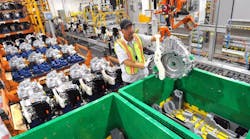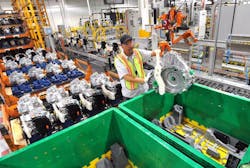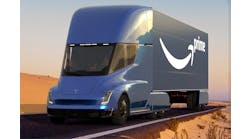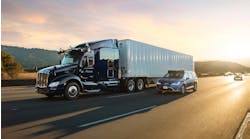Here’s an effort worth keeping an eye on: Ford Motor Co. is launching what it calls a five-year global waste reduction strategy that aims to reduce by 40% the amount of waste sent to landfills between 2011 and 2016 from its manufacturing operations – equal to 13.4 pounds per vehicle worldwide.
The automaker said this new plan builds on success waste reduction efforts achieved between 2007 and 2011, when the amount of waste sent to landfill per vehicle dropped from 37.9 to 22.7 pounds – a 40% reduction.
This isn’t all about being a “green do-gooder” either. Indeed, John Fleming, Ford’s executive VP global manufacturing and labor affairs, noted that the automaker generated $225 million in revenue last year ALONE by recycling of 568,000 tons of scrap metal in the U.S. and Canada – a significant pile of cash, if you ask me.
So what is Ford aiming to cut, reduce, or recycle to achieve such waste reduction savings? For starters, the automaker is looking to beef up new efforts such as paint waste recycling recently launched at its facilities in Australia, Thailand, India and Spain.
[Watch how Ford makes its 1-liter EcoBoost engines in Europe; you can readily see how little scrap waste is left over in this particular manufacturing process.]
Ford said it also plans to continue reducing the amount of waste-to-landfill by emphasizing prevention, minimization, reuse and recycle of waste whenever possible – which include trying to reduce or eliminate certain kinds of waste from entering Ford facilities in the first place.
Here are some near-term goals for waste reduction the OEM established via its new five-year plan:
- Identify the five largest volume waste-to-landfill streams at each plant, developing plans to reduce each and tracking progress;
- Minimize waste by continuing to drive “lean” manufacturing;
- Improving waste sorting procedures to make recycling and reuse easier;
- Investing in new technologies that minimize waste, such as dry-machining;
- Expanding programs that deal with managing specific kinds of waste like metallic particles from the grinding process and paint sludge.
Some of the more formalized targets Ford hopes to achieve via this new five-year effort include:
- Greenhouse gas emissions: Reduce from manufacturing facilities by 30% per vehicle between 2010 and 2025
- Water use: Reduce the amount used in the manufacture of each vehicle by 30% between 2009 and 2015
- Energy consumption: 25% reduction in average consumption per vehicle globally between 2011 and 2016
Dave Lewis, environmental engineer at the Van Dyke plant, said he believes one particular aspect of the new global waste strategy could yield the best results – enabling and encouraging local personnel to affect change.
"It's very empowering to be able to address a problem that is so important – and not just to our plant or our company – but society in general,” he explains. "Without the power to implement such change, some of the best solutions could never see the light of day."
Between 2010 and 2012, Van Dyke kept 111 tons of waste from landfills, becoming a zero waste-to-landfill plant in late 2012 after its environmental committee found on their own separate recyclers for the used filters and the materials they contained post-use.
Robert Brown, Ford’s VP for sustainability, environment and safety engineering, said the Van Dyke plant is being used as a model for Ford facilities around the world, exemplifying how Ford will succeed in reaching the goals outlined in the new waste reduction strategy.
"We are always evaluating how our operations handle waste around the world, and we consider Van Dyke just one of many successes we've had," he noted. "We use Van Dyke's waste reduction efforts to not only exemplify what can be done, but what should be done."




